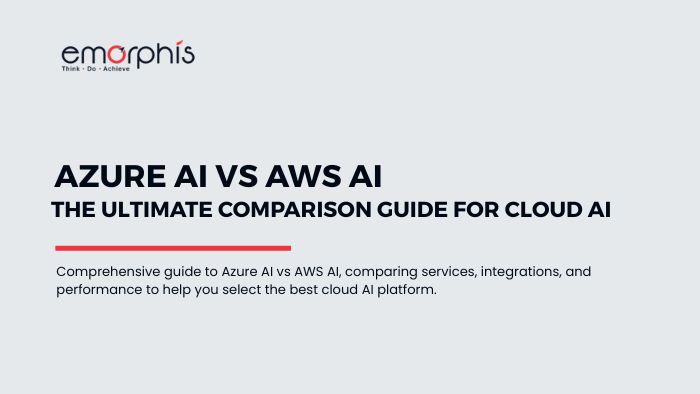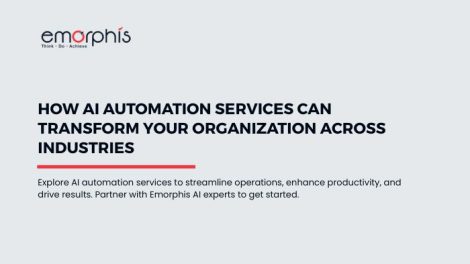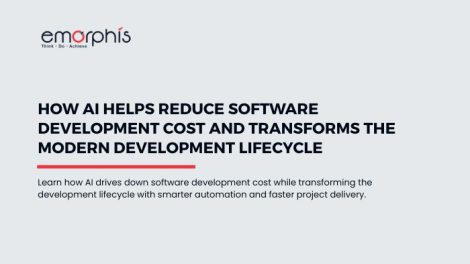Introduction to Azure AI vs AWS AI
In the competitive world of cloud-based artificial intelligence, the battle between Azure AI vs AWS AI has become one of the most discussed topics among enterprise technology leaders. With both platforms offering a rich set of AI services, choosing the right provider can significantly impact development speed, performance, and total cost of ownership for businesses leveraging cloud AI.
Azure AI, built on Microsoft’s robust cloud ecosystem, provides advanced tools like Azure Machine Learning, Azure OpenAI, and Cognitive Services to enable developers and enterprises to build, deploy, and manage AI models with minimal friction. On the other hand, AWS AI offers a broad array of tools such as Amazon SageMaker, Rekognition, Lex, and Comprehend, positioning itself as a flexible and scalable platform for deep learning and AI application development.
If you’re looking to integrate cloud-based AI solutions into your infrastructure or build enterprise-grade AI applications, this Azure AI vs AWS AI guide will help you understand the key differences, performance benchmarks, and strategic advantages of each.

As of 2025, both Microsoft Azure and Amazon Web Services dominate the cloud AI market, but with different strengths. According to recent market intelligence, AWS continues to lead the overall cloud services space, but Azure AI is closing the gap in enterprise AI adoption, especially in industries like healthcare, finance, and government.
- Azure AI vs AWS AI in Enterprise: Microsoft Azure has gained significant ground due to its seamless integration with Microsoft 365, Power BI, and Dynamics 365, making it the preferred choice for enterprises already within the Microsoft ecosystem.
- AWS AI Adoption: Amazon’s long-standing leadership in cloud computing has made AWS AI the first choice for startups, ecommerce businesses, and organizations looking for fine-grained control and powerful customization options.
- Gartner & Forrester Insights: Multiple analyst reports rank both platforms as leaders, but often cite Azure as more enterprise-friendly, while AWS is noted for depth of services and developer control.
With growing investments in AI infrastructure, both platforms continue to evolve. This Azure AI vs AWS AI comparison will explore whether Microsoft’s enterprise focus or Amazon’s cloud-native flexibility best suits your business goals.
Now that we’ve established the market landscape and adoption trends, let’s delve into the heart of the comparison: AI service portfolios. What tools, APIs, and model-building options do Azure AI vs AWS AI offer in 2025, and how do they cater to the needs of developers, startups, and large enterprises?
Core Offerings: Azure AI vs AWS AI
When comparing Azure AI vs AWS AI, the most noticeable difference lies in the structure and naming of services, yet both offer robust capabilities across machine learning, computer vision, NLP, and speech services. Each platform provides a mix of prebuilt APIs and services for developers who want fast deployment, as well as advanced environments for custom model training.
Azure AI Services Overview
- Azure Machine Learning (Azure ML): A powerful platform for building, training, and deploying machine learning models at scale. It supports MLOps, automated ML, and model interpretability tools.
- Azure Cognitive Services: A collection of APIs for vision, speech, language, and decision-making tasks. Ideal for developers who want plug-and-play AI capabilities.
- Azure OpenAI Service: Provides direct access to GPT models from OpenAI with enterprise-grade compliance, suitable for building intelligent agents and copilots.
- Azure AI Studio: A recent addition that unifies AI services under a collaborative development environment.
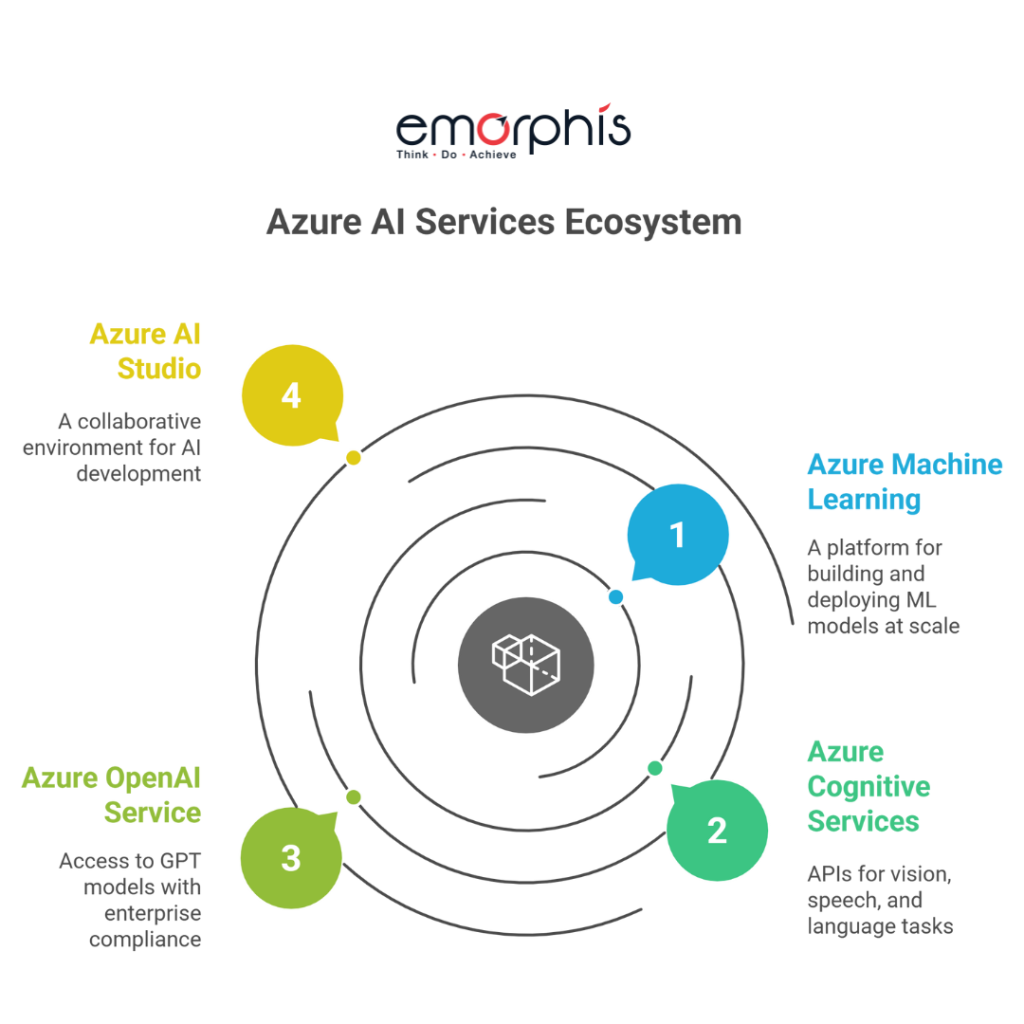
AWS AI Services Overview
- Amazon SageMaker: AWS’s flagship machine learning platform, designed for end-to-end model development, deployment, tuning, and monitoring. It includes built-in algorithms, Jupyter notebooks, and AutoML.
- Amazon Rekognition, Comprehend, Polly, and Lex: Specialized AI services for image analysis, NLP, text-to-speech, and conversational bots.
- Amazon Bedrock: Introduced as a serverless platform to integrate foundation models (FM) like Anthropic Claude, Amazon Titan, and Meta LLaMA 2 into applications without managing infrastructure.
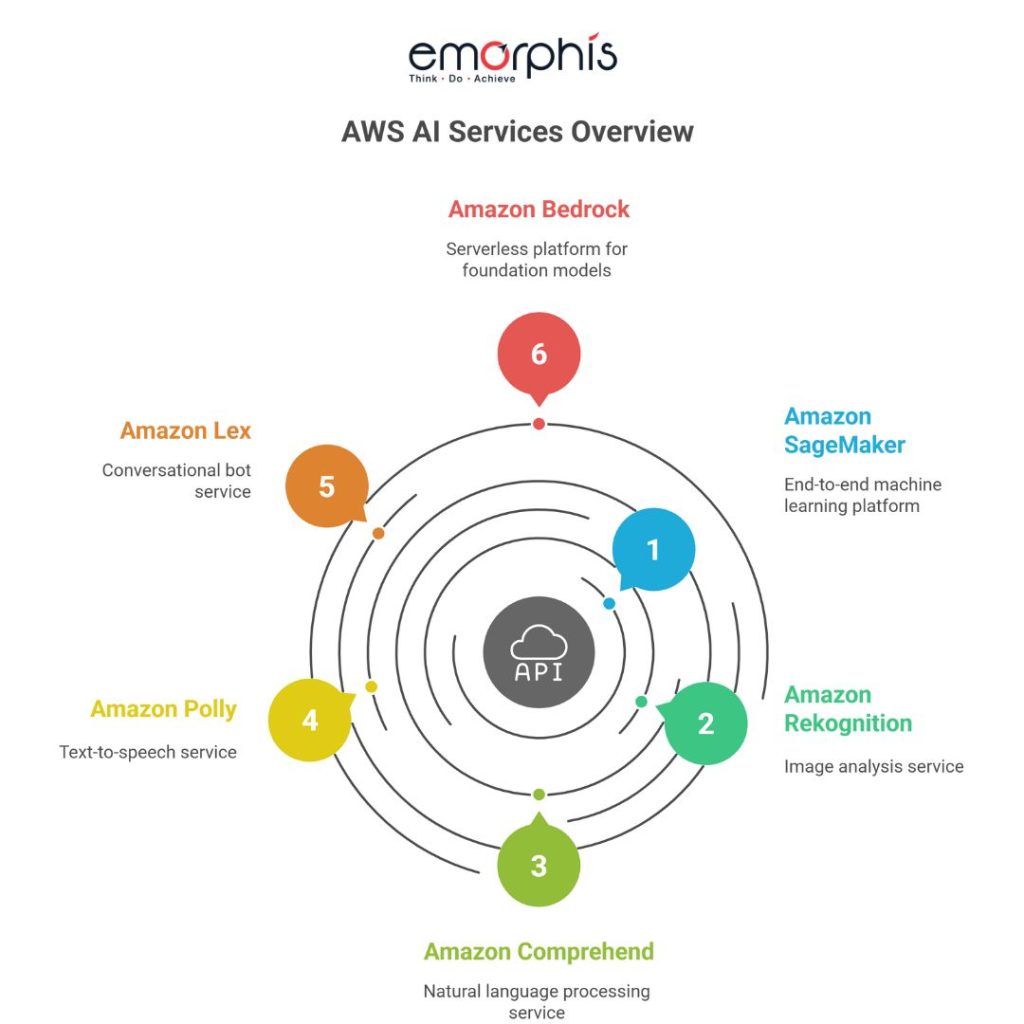
Prebuilt Models vs Custom Development
In terms of development paths, Azure AI vs AWS AI each caters to different preferences:
- Azure AI leans toward ease of use with prebuilt services that simplify AI adoption for enterprises and citizen developers. It’s particularly useful for organizations building AI-powered business intelligence dashboards or integrating AI into Microsoft applications like Teams or Power BI.
- AWS AI is favored by data scientists and ML engineers who require full control over model architecture, data pipelines, and infrastructure scaling.
This flexibility makes AWS AI ideal for advanced machine learning use cases, while Azure AI appeals more to businesses seeking AI automation without deep model customization.
Developer Experience and APIs
Whether you’re building AI applications from scratch or looking to add intelligence to existing workflows, both platforms provide strong developer support.
- Azure SDKs and REST APIs are available in Python, C#, Java, and JavaScript, and integrate easily into Microsoft Azure DevOps pipelines.
- AWS SDKs are similarly extensive, with tight integration into AWS Lambda, CloudFormation, and CI/CD tools like CodePipeline.
This is a crucial factor in the Azure AI vs. AWS AI debate, particularly for companies with existing DevOps infrastructures.
Cross-Cloud Integration and API Ecosystem
- Azure AI works seamlessly with Microsoft Power Platform, Dynamics 365, and Azure Data Lake, making it ideal for enterprises already invested in the Microsoft cloud stack.
- AWS AI, on the other hand, offers deep integration with Amazon Kinesis, Redshift, and the broader AWS data ecosystem, which benefits data-driven companies with high-throughput workloads.
In 2025, businesses looking to migrate to a cloud AI provider often make decisions based on these integration capabilities.
We’ve now explored the service portfolios. But how do Azure AI vs AWS AI stack up when it comes to machine learning capabilities, model automation, and MLOps? In the next part, we’ll dive deep into how both platforms enable scalable and efficient ML workflows.
Machine Learning Capabilities and NLP – Azure AI vs AWS AI
Machine Learning and AutoML Capabilities
One of the core areas of comparison in Azure AI vs AWS AI is how both platforms support machine learning model development—from prototyping to production deployment. In 2025, AutoML and MLOps have become essential for teams seeking faster time-to-value and scalable deployment options.
Azure AI ML Tools
- Azure Machine Learning provides a complete ecosystem for data scientists and engineers to manage datasets, train models, validate results, and monitor deployed services.
- It supports AutoML, drag-and-drop visual interfaces for non-coders, and full integration with Azure DevOps for continuous integration and deployment.
- Azure’s MLOps capabilities allow versioning of datasets, code, and models while offering tools for model drift detection, reproducibility, and model explainability.
AWS ML Tools
- Amazon SageMaker offers an end-to-end machine learning environment with advanced tools like SageMaker Pipelines, SageMaker Experiments, and SageMaker Model Monitor.
- With SageMaker Autopilot, developers can generate optimized ML pipelines automatically without deep ML expertise.
- AWS also excels in giving granular control over compute (EC2, Graviton), storage (S3), and data ingestion (Kinesis, Glue).
So, in the battle of Azure AI vs AWS AI in machine learning workflows:
- Choose Azure AI if you want a faster ramp-up with low-code ML tools and deep integration with Microsoft cloud products.
- Choose AWS AI if you need infrastructure-level flexibility, hybrid deployment options, and robust MLOps for highly customized use cases.
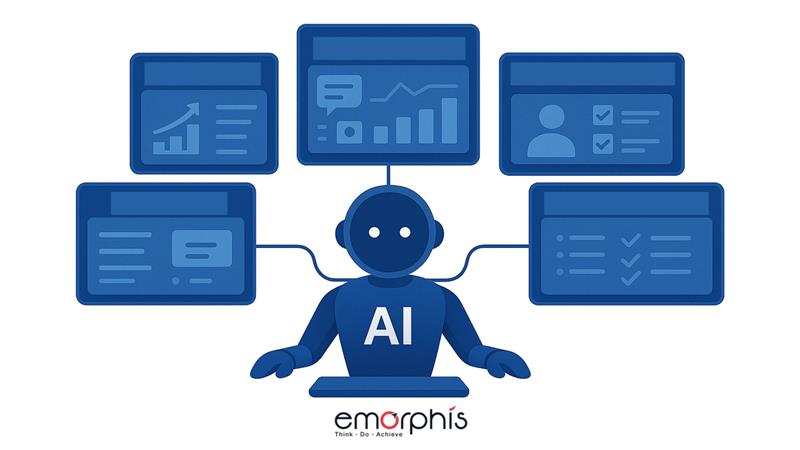
Natural Language Processing (NLP) Capabilities
In 2025, NLP is a must-have feature for building chatbots, analyzing customer feedback, summarizing documents, and enabling voice-based commands. Here’s how Azure AI vs AWS AI compares in natural language understanding and processing:
Azure AI NLP Tools
- Azure Text Analytics handles language detection, entity recognition, key phrase extraction, sentiment analysis, and summarization across over 120 languages.
- Azure’s Language Understanding Intelligent Service (LUIS) enables custom model creation for industry-specific NLP tasks.
- With Azure OpenAI, organizations can now integrate GPT-powered language capabilities while staying compliant with security and governance requirements.
AWS AI NLP Tools
- Amazon Comprehend provides sentiment analysis, language detection, custom entity recognition, and document classification. It’s widely used in e-commerce, healthcare, and financial services.
- AWS’s Lex allows for conversational bot development that integrates with other AWS services like Lambda and Connect.
- For more advanced language modeling, Amazon Bedrock enables access to LLMs like Anthropic Claude and Meta LLaMA 2.
Both platforms continue to improve their NLP accuracy, multilingual support, and latency. In terms of Azure AI vs AWS AI:
- Azure AI is ahead in enterprise-ready integrations and regulated environments.
- AWS AI stands out for building custom NLP pipelines in high-performance environments.
With NLP and ML explored, the next area of comparison in Azure AI vs AWS AI is in computer vision and speech technologies. These services are critical for building applications that can see, interpret, and interact with the world, ranging from facial recognition to real-time transcription.
Computer Vision and Speech – Azure AI vs AWS AI
Computer Vision Capabilities
When evaluating Azure AI vs AWS AI in computer vision, both platforms offer a comprehensive set of APIs and tools for analyzing images, videos, and visual content. These are widely used in industries like healthcare, retail, security, manufacturing, and automotive.
Azure AI Computer Vision Tools
- Azure Computer Vision API supports image tagging, optical character recognition (OCR), object detection, facial recognition, and spatial analysis.
- The Azure Face API allows developers to detect, identify, and analyze human faces with high accuracy.
- Azure’s Video Indexer uses AI to extract metadata, spoken words, faces, and emotions from videos, helping media companies accelerate content production and compliance.
AWS AI Computer Vision Tools
- Amazon Rekognition offers facial analysis, object and scene detection, celebrity recognition, and unsafe content moderation.
- Rekognition Video extends these capabilities to real-time streaming video analysis.
- AWS also supports custom labeling models through SageMaker Ground Truth, which makes it easier to train domain-specific CV models.
In the Azure AI vs AWS AI computer vision matchup:
- Azure AI is preferred by businesses that require rapid implementation and tighter integration with office workflows.
- AWS AI is suitable for companies needing scalable, real-time visual analytics, often with tighter control over the training process.
Speech Recognition and Synthesis
Speech services are an essential part of modern AI applications—from real-time transcription in call centers to building voice assistants and audio search tools. Here’s how Azure AI vs AWS AI compares in speech technologies.
Azure Speech Services
- Azure Speech-to-Text provides accurate transcription across dozens of languages with support for real-time and batch processing.
- The Azure Text-to-Speech can synthesize speech in over 110 voices and styles using neural voice models.
- It also offers Speaker Recognition, which can identify or verify speakers from voice samples.
- Azure’s speech services are easily integrated into applications built with Microsoft Teams, Dynamics, and Windows.
AWS Speech Tools
- Amazon Transcribe provides automatic speech recognition (ASR) for real-time and recorded audio. It includes features like custom vocabulary, speaker identification, and channel separation.
- Amazon Polly turns text into natural-sounding speech and supports multiple voices and languages.
- Polly’s NTTS (Neural TTS) delivers life-like speech for use cases like news reading, IVR systems, and virtual agents.
Between Azure AI vs AWS AI:
- Azure AI delivers rich integrations into Microsoft’s communication stack and supports real-time collaboration scenarios.
- AWS AI offers slightly more flexibility for multimodal voice experiences and custom voice model deployment.
As important as features are, the real value lies in how seamlessly these services can be integrated and secured within broader enterprise systems. In the next part of our Azure AI vs AWS AI comparison, we’ll look at ecosystem integration, security, governance, and cloud-native compatibility, all of which can be deciding factors for businesses scaling with AI.
Ecosystem Integration and Security – Azure AI vs AWS AI
Integration with Other Cloud Services
When evaluating Azure AI vs AWS AI, it’s not just about standalone services; it’s also about how seamlessly those services integrate into your broader cloud infrastructure. This is where the existing enterprise tech stack plays a major role in influencing the platform choice.
Azure AI Ecosystem Integration
- Microsoft Power Platform: Azure AI integrates effortlessly with Power BI, Power Automate, and Power Apps, making it ideal for low-code AI app development.
- Dynamics 365 & Office 365: Native compatibility with Microsoft’s enterprise software makes Azure AI an easy win for organizations using tools like Excel, Teams, or Outlook.
- Azure Data Lake, Synapse, and Databricks: Azure AI also benefits from tight integration with Azure’s big data and analytics ecosystem, improving model training, data pipeline management, and reporting.
AWS AI Ecosystem Integration
- Amazon Redshift, Glue, and Athena: AWS AI tools work in tandem with AWS’s robust data services, making it a strong choice for big data-driven AI models.
- AWS Lambda & Step Functions: Developers can connect AI models with serverless functions for event-driven processing or microservice orchestration.
- Third-party Model Integration: Through Amazon Bedrock, developers can now use foundation models from AI leaders like Anthropic and Meta, an important edge in the Azure AI vs AWS AI space.
If your organization is already committed to the Microsoft ecosystem, Azure AI offers a smoother path. If you’re invested in highly scalable, decoupled systems with broader third-party ML flexibility, AWS AI is likely the better choice.

Security, Compliance, and Governance
In regulated industries like healthcare, finance, and government, security is a key decision factor. Both Azure and AWS take enterprise-grade security seriously, but they offer slightly different governance models and compliance tooling.
Azure AI Security Features
- Role-Based Access Control (RBAC) and Azure Active Directory enable fine-grained identity and policy management.
- Azure provides strong compliance coverage, including HIPAA, GDPR, ISO 27001, FedRAMP, and more.
- Model auditing and responsible AI features, like Fairlearn integration, explainability dashboards, and bias detection, help meet ethical AI requirements.
AWS AI Security Features
- Identity and Access Management (IAM) is highly customizable, supporting policies down to the individual resource level.
- AWS supports data encryption at rest and in transit, including custom KMS keys.
- AWS’s robust compliance framework also includes SOC 2, PCI DSS, HIPAA, and others, along with fine-tuned controls for model governance through SageMaker Clarify and Audit Manager.
So, who leads in security in the Azure AI vs AWS AI race? Both are enterprise-ready, but:
- Azure AI shines when used in Microsoft-centric regulated environments with strong audit requirements.
- AWS AI offers slightly more developer control and detailed security configuration options across diverse infrastructure setups.
With features and security reviewed, the next practical consideration in choosing between Azure AI vs AWS AI is cost efficiency and performance. From training times to real-time inference latency, and the pricing models behind them, will cover how both platforms handle enterprise-grade AI workloads at scale.
Cost, Performance, and Customization – Azure AI vs AWS AI
Pricing Models and Cost Comparison
When comparing Azure AI vs AWS AI, pricing plays a major role, especially for organizations building at scale or operating on tight budgets. Both platforms follow pay-as-you-go models, but they differ in how services are priced and bundled.
Azure AI Pricing Highlights
- Azure Machine Learning charges for compute hours, data storage, and model training separately. It offers both dedicated compute instances and spot pricing options.
- Azure Cognitive Services are priced per 1,000 transactions, with additional charges for features like image analysis, speech recognition, or sentiment scoring.
- The Azure OpenAI Service introduces token-based pricing aligned with GPT model usage, ideal for businesses building LLM-based assistants and copilots.
AWS AI Pricing Highlights
- Amazon SageMaker’s pricing includes notebook usage, training jobs, endpoint hosting, and model monitoring, offering greater control but also more complexity.
- The Amazon Rekognition and Comprehend are priced per unit (e.g., per image or per document), while Polly and Transcribe charge per second of audio processed.
- Amazon Bedrock uses token pricing for foundation model access, similar to Azure OpenAI, but offers multiple model vendors.
To summarize Azure AI vs AWS AI on cost:
- Azure AI is typically simpler for budgeting in enterprises with pre-defined use cases.
- AWS AI offers granular cost control for developers with the expertise to optimize resource usage across modular services.
Performance and Scalability
In 2025, cloud AI platforms are expected to support both real-time AI applications (like virtual assistants and fraud detection) and batch AI processing (such as medical image analysis or customer segmentation). Here’s how Azure AI vs AWS AI performs:
Azure AI Performance
- Azure leverages its global data center network and GPU-enabled clusters to deliver low-latency inference and fast model training.
- The Azure ML now supports optimized hardware accelerators and distributed training with deep learning frameworks like PyTorch, TensorFlow, and ONNX.
- For high-throughput tasks like video analysis, Azure offers scalable parallel processing via Batch AI and container instances.
AWS AI Performance
- AWS supports high-performance compute options like Inf1/Inf2 and Trainium chips, designed specifically for inference and training.
- Elastic Inference, auto-scaling endpoints, and on-demand GPU instances provide more precise resource tuning for ML engineers.
- AWS’s broader region coverage and edge capabilities through AWS Wavelength make it ideal for low-latency edge AI deployments.
So, when comparing Azure AI vs AWS AI performance:
- Choose Azure AI for optimized performance with minimal configuration in enterprise applications.
- Choose AWS AI if you’re running complex, high-frequency inference or multi-region AI deployments with custom scaling logic.
Customization and Flexibility
Customization is where the Azure AI vs AWS AI difference becomes very apparent, especially for advanced teams building proprietary AI solutions.
- Azure AI supports custom training but emphasizes enterprise-ready APIs, guardrails, and low-code interfaces. It’s built for speed and simplicity.
- AWS AI gives developers deep control over model parameters, containers, and infrastructure, making it ideal for those wanting to fine-tune everything from scratch.
If your goal is to rapidly deploy AI within a regulated enterprise stack, Azure wins on speed. If you’re building novel AI models for unique use cases, AWS offers more building blocks.
We’ve now explored all the technical and operational differences. In the final part of our Azure AI vs AWS AI comparison, we’ll look at specific use cases, industry-fit, and provide a verdict to help you choose the right AI platform in 2025 and beyond.

Which Platform Should You Choose for These AI Use Cases? Top 10 Use cases questions and answers for Azure AI vs AWS AI
1. Need to build an AI-powered business app integrated with Microsoft 365?
Verdict:
Azure AI is the better choice.
With native integration across Microsoft Teams, Excel, Power BI, and Dynamics 365, Azure AI allows faster deployment and secure collaboration inside enterprise environments already using the Microsoft ecosystem.
2. Want to build custom machine learning models with full control over infrastructure?
Verdict:
AWS AI leads here.
Amazon SageMaker, combined with EC2, custom containers, and distributed training options, makes AWS the ideal platform for developers who need full customization over model pipelines, resource allocation, and performance tuning.
3. Looking for fast deployment of AI with minimal coding?
Verdict:
Azure AI wins.
Azure Cognitive Services and Azure Machine Learning Studio offer a low-code environment and AutoML, enabling faster deployment of production-grade AI models without needing deep ML experience.
4. Building real-time analytics and AI applications at global scale?
Verdict:
AWS AI performs better.
With services like Amazon Kinesis, Lambda, and Rekognition Video, AWS supports real-time, high-throughput, and edge deployments better than Azure, especially for businesses with global infrastructure needs.
5. Need AI in a healthcare or finance application with high compliance needs?
Verdict:
Azure AI is ideal.
Azure offers advanced compliance tooling (GDPR, HIPAA, ISO, FedRAMP) and Responsible AI features like model interpretability and bias detection, making it better suited for highly regulated environments.
6. Planning to embed generative AI (like ChatGPT) into your business workflows?
Verdict:
Azure AI has the edge.
Through the Azure OpenAI Service, Microsoft provides secure, enterprise-ready access to OpenAI’s models—ideal for chatbots, copilots, summarization tools, and content generation.
7. Want to process and analyze huge volumes of structured and unstructured data?
Verdict:
AWS AI is better equipped.
AWS excels in data handling with tools like Redshift, Glue, Athena, and SageMaker Data Wrangler, making it a stronger platform for enterprises building data-heavy AI pipelines.
8. Developing AI-powered speech and voice applications across multiple devices?
Verdict:
AWS AI is more flexible.
Amazon Polly, Transcribe, and Lex offer high-quality speech synthesis and voice interfaces that scale across contact centers, devices, and mobile apps.
9. Looking to rapidly prototype and deploy AI with budget predictability?
Verdict:
Azure AI is the better fit.
Azure’s bundled services, predictable per-transaction pricing, and strong developer tools make it easier to manage costs during prototyping and production rollout.
10. Need cross-cloud or hybrid cloud AI compatibility?
Verdict:
AWS AI has broader support.
AWS provides more tools for building hybrid and multicloud AI applications, including deployment across on-premises, edge, and third-party environments.
Conclusion: Azure AI vs AWS AI – Making the Right Decision for Your AI Strategy
Choosing between Azure AI vs AWS AI is not a one-size-fits-all decision. Both platforms offer powerful, mature, and enterprise-ready AI tools—but the best choice depends entirely on your organization’s goals, technical maturity, existing infrastructure, and regulatory needs.
- If your organization values ease of use, enterprise integration, and faster time-to-deployment, especially within Microsoft environments, Azure AI is a clear winner.
- If you prioritize customization, deep ML control, scalable data pipelines, and fine-grained resource optimization, AWS AI offers the flexibility and robustness you need.
- In 2025, as AI adoption accelerates across all industries, the Azure AI vs AWS AI decision will significantly influence how efficiently you innovate, how securely you operate, and how fast you scale.
For startups building from scratch, tech-heavy firms designing custom AI pipelines, or global companies deploying AI across distributed infrastructures, AWS AI provides greater architectural freedom.
For regulated industries, enterprise IT teams, and businesses seeking low-code, secure, and tightly integrated AI solutions, Azure AI simplifies adoption while ensuring compliance and governance.
Ultimately, both platforms are future-proof, and choosing the right one is less about who’s better overall and more about who’s better for you.

Azure AI vs AWS AI Comparison Table
| Category | Azure AI | AWS AI |
| Market Adoption | Strong in enterprise and regulated industries | Dominant among startups, big tech, and developer-led teams |
| AI Services Portfolio | Azure Cognitive Services, Azure ML, Azure OpenAI, AI Studio | SageMaker, Rekognition, Comprehend, Lex, Bedrock |
| Machine Learning | Simplified AutoML, integrated with Azure ML Studio, great for citizen developers | Full control via SageMaker, AutoPilot, pipelines, experiments |
| Natural Language Processing (NLP) | Text Analytics, LUIS, OpenAI integration for LLMs | Amazon Comprehend, Lex, Bedrock (Claude, Titan, LLaMA) |
| Computer Vision | Face API, OCR, spatial analysis, Video Indexer | Rekognition for images and video, unsafe content moderation |
| Speech Recognition & Synthesis | Speech-to-Text, Text-to-Speech, Speaker Recognition | Transcribe, Polly (Neural TTS), real-time voice interaction |
| Developer Tools & SDKs | SDKs in Python, Java, C#, JS; integrated with Azure DevOps | SDKs for all major languages; deep CI/CD and Lambda support |
| Ecosystem Integration | Tight integration with Microsoft 365, Dynamics, Power Platform | Strong integration with Redshift, S3, Lambda, QuickSight |
| Security & Compliance | Enterprise-grade governance, RBAC, FedRAMP, HIPAA, Responsible AI tools | IAM flexibility, full encryption control, SageMaker Clarify |
| Pricing Model | Predictable API and compute pricing; good for enterprises | Complex but granular pricing for advanced users and scaling |
| Performance & Scalability | Optimized for business workloads and seamless scaling | More flexibility, better for custom real-time inference workloads |
| Customization & Flexibility | Best for low-code AI with governance controls | Ideal for full-stack AI engineering and infrastructure-level tuning |
| Enterprise Readiness | High; turnkey solutions and compliance-first design | Moderate; requires customization to meet specific enterprise needs |
| Best For | Enterprises, healthcare, finance, government, Microsoft-centric IT | Startups, tech firms, ecommerce, data science teams |
| Use Case Fit | Low-code enterprise AI, conversational agents, analytics | Custom ML workflows, global-scale deployments, big data AI |
| Generative AI Support | Azure OpenAI for secure enterprise-grade LLMs | Amazon Bedrock with multiple foundation model choices |



